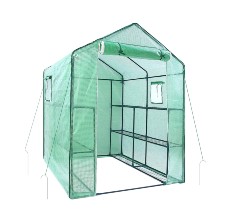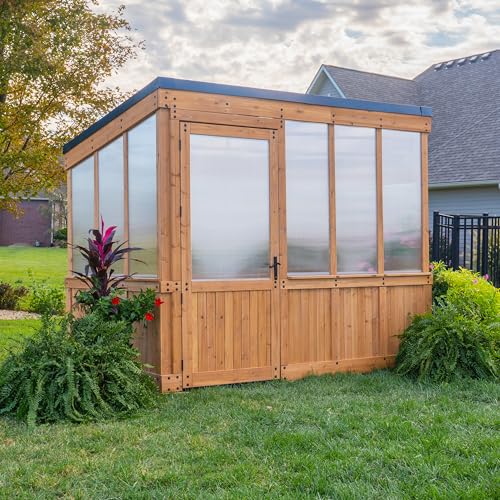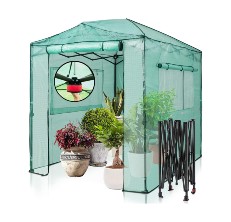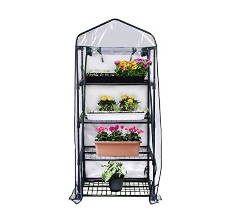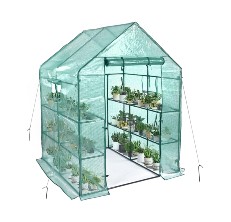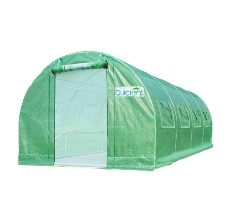Greenhouses help you control the climate and ultimately extend the growing season, allowing you to grow tropical and subtropical plants in relatively cold weather. By creating the ideal environment, they give you the ability to grow multiple kinds of crops throughout the year while ensuring a maximum yield. To help you elevate your gardening success, we’ve reviewed some of the best greenhouses of 2024. The Ohuhu Walk-in Greenhouse is our top pick because it's stable and well-ventilated, ensuring your crops can thrive in any season. Explore our buying guide and reviews to see which option is best suited for your gardening needs.
Our Top Picks For Greenhouses
A Buyer's Guide: Greenhouses
There are several factors you should consider before buying a greenhouse, and this guide comprehensively explains them:
What Is a Greenhouse?
Greenhouses give plants the appropriate environment they need to grow and multiply. They’re made to protect out-of-season and tender plants from the extremities of the weather outside. Greenhouses work on the basic principle of trapping and retaining heat energy. This heat induces and promotes plant growth in off-season plants, allowing you to have a supply of your favorite flowers and plants throughout the year.
Greenhouse coverings are made from materials like polycarbonate, polyethylene, or glass that let the heat from the sun and other sources pass through into the enclosed space. This heat is trapped inside the space and is absorbed by plants.
Carbon dioxide is a free and heavy natural gas that stays at a lower level in the greenhouse, ensuring crops meet their photosynthesis potential.
However, it’s essential to monitor the carbon emissions through sensors and adjust to the required level. Commercial greenhouses use paraffin lamps to increase the rate of photosynthesis, as burning paraffin produces carbon dioxide as well as heat.
Check the video below by gardening expert Chris to learn more about the basics of greenhouse growing.
Things to Consider Before Buying a Greenhouse
When setting up a greenhouse, it’s important to consider numerous things to give your plants much-needed care. While professionals at garden centers can offer you the best guidance about choosing plants, we’ve assembled tips that can help you in choosing the best greenhouse for your backyard or deck.
Frame material
You can either get a wooden frame or a metal one for your greenhouse. Aluminum is a cheaper option between the two and is also very long-lasting. It’s low maintenance and you can also powder coat it in a wide range of colors. Wood, particularly timber, is a common choice amongst people who want to make their greenhouse and the space around it attractive. They do require more upkeep and are relatively expensive. However, they’re better at maintaining the temperature inside for longer times. You can glaze them to the ground or make a lean-on greenhouse out of wooden ones.
Size
Greenhouses come in a large range of sizes, with 2ft increments of a range of widths and lengths. The ideal size would be a 6ft wide and 8ft tall greenhouse that will enable you to put shelves on each side.
The eaves of your greenhouse should at least be 5ft tall so it can allow plenty of light in for the plants. The size also depends on the kind and quantity of plants you’re planning to maintain.
Shape
The shape of your greenhouse is important because it decides what movability options you’re going to have. There are three main shapes: lean-on, traditional, and octagonal. Dome or octagonal shapes are perfect for those who don’t have a lot of ideal space. Lean-on designs lean onto already existing walls and get support from the bricks of the house as well. This helps them maintain a constant temperature throughout the year.
Ventilation
Ventilation is another important factor that your greenhouse should have. Especially for the summer season, a mesh door is perfect to let fresh air in while preventing invasion from bugs or small animals around. Most greenhouses have hinged roof vents, side vents, windows, and doors for ventilation purposes. Sufficient vent openings around the perimeter of the greenhouse are essential as cross ventilation is ideal for natural gas to escape.
Where Should a Greenhouse Be Placed?
There are limited areas where you can put a greenhouse in your house. Here are some simple tips for choosing where to place a greenhouse:
- You should look for a spot that is sheltered but avoid placing it under a tree because there is a risk of potential damage there.
- Place your greenhouse in a spot that receives an abundance of sunlight. Sunlight is necessary for plants to grow and it helps maintain a warm, suitable temperature inside.
- Don’t place the greenhouse where it will be exposed to winds. No matter how big or heavy, storms and heavy winds tend to damage it.
- There should be plenty of space around all sides of a greenhouse. There must be space for efficient cleaning and room for greenhouse-raised crops and plants outside.
- Get one that can be placed as near to the house as possible so that it can remain warm without electricity or any other source.
Types of Greenhouses
There are three basic kinds of greenhouses. Let’s take a look at all of these:
Pop-up greenhouse
Pop-up greenhouses are also known as ultra-mobile greenhouses. They look somewhat like freestanding ones but are small in size overall. They are highly portable and usually very easy to assemble and disassemble. You can easily pack it up and move it to a space that you like. When you can easily transport a greenhouse, it becomes easier to get the right amount of sunlight at the right position in different weather conditions.
Lean-to greenhouse
Lean-to greenhouses are attached to the outer walls of your home or building. They’re rather smaller and have less space for people to walk inside them, but they’re great for keeping little plants and crops and growing them to a certain size. This is the perfect choice for a backyard greenhouse maintained by occasional or casual gardeners. They’re usually cheap, but if you plan to get wooden frames attached to your house with them, it can turn into a costly project. Lean-to greenhouses are energy-efficient and give the house a nice look from the outside.
Free-standing greenhouse
This is the most commonly used gardening greenhouse. They’re like small separate houses with their own construction and independent structures. They commonly have A-Frame-shaped roofs with a round-arch shape to keep water and snow from accumulating on the top. Free-standing backyard greenhouses are expensive as they require much more material and serious construction than the other two kinds, but they’re spacious and allow you to keep a lot of plants inside.
People Also Asked
What is the best time to buy a greenhouse?
The most suitable time to get a greenhouse is mid-winter. Buy 3 or 4 weeks before your planned time to start growing.
Is a green greenhouse better than a clear one?
Clear greenhouses are recommended more than any colored ones. Colors might block some spectrums of natural light from penetrating inside.
Are greenhouses worth it?
Yes. They allow you to grow vegetables, plants, and flowers all year long. Consult experts from garden centers for the best collection of plants.




